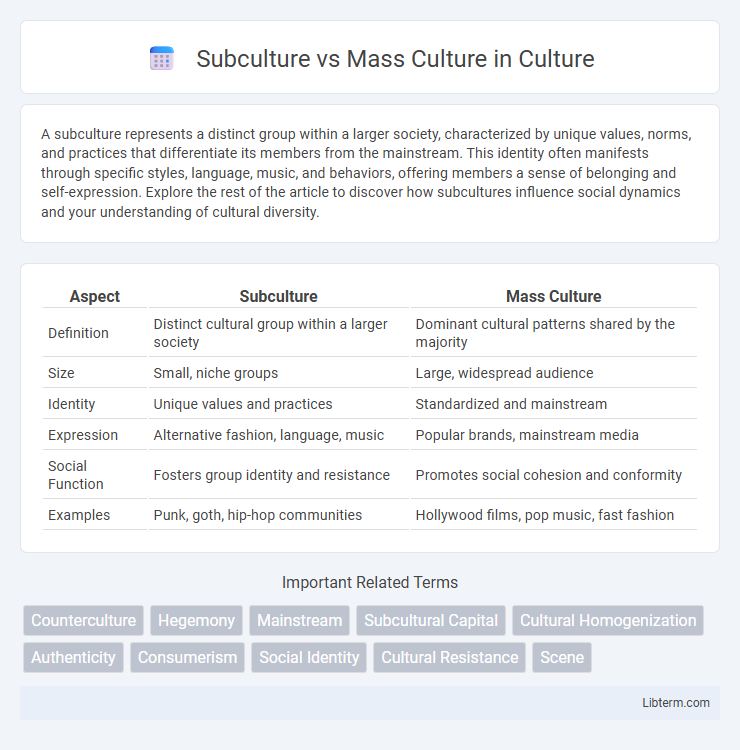A subculture represents a distinct group within a larger society, characterized by unique values, norms, and practices that differentiate its members from the mainstream. This identity often manifests through specific styles, language, music, and behaviors, offering members a sense of belonging and self-expression. Explore the rest of the article to discover how subcultures influence social dynamics and your understanding of cultural diversity.
Table of Comparison
| Aspect | Subculture | Mass Culture |
|---|---|---|
| Definition | Distinct cultural group within a larger society | Dominant cultural patterns shared by the majority |
| Size | Small, niche groups | Large, widespread audience |
| Identity | Unique values and practices | Standardized and mainstream |
| Expression | Alternative fashion, language, music | Popular brands, mainstream media |
| Social Function | Fosters group identity and resistance | Promotes social cohesion and conformity |
| Examples | Punk, goth, hip-hop communities | Hollywood films, pop music, fast fashion |
Defining Subculture and Mass Culture
Subculture refers to a group within a larger society that differentiates itself through distinct values, norms, and practices, often resisting mainstream cultural norms. Mass culture encompasses the widespread cultural elements, products, and activities that are produced and consumed on a large scale, typically characterized by standardized, commercialized entertainment and media. Understanding the defining features of subculture highlights its role in identity formation and social resistance, while mass culture emphasizes uniformity and broad accessibility.
Historical Origins of Subculture and Mass Culture
Subcultures originated in the mid-20th century as distinct social groups formed around shared values, styles, and behaviors that often resisted mainstream norms established during the industrial and post-industrial periods. Mass culture emerged simultaneously, driven by technological advances in mass production, mass media, and consumerism, facilitating widespread dissemination of homogeneous cultural products aimed at large audiences. Historical studies highlight how subcultures served as sites of identity negotiation and resistance, contrasting with mass culture's role in promoting social conformity and commercial uniformity.
Key Characteristics of Subcultures
Subcultures are defined by distinct values, norms, and behaviors that differentiate them from mainstream mass culture, often emerging as a response to or resistance against dominant societal norms. Key characteristics include a shared identity among members, unique styles of dress, language, and rituals that foster a strong sense of belonging and community. These groups frequently challenge or redefine cultural standards through alternative expressions of art, music, and social practices, emphasizing individuality within collective cohesion.
Features of Mass Culture
Mass culture is characterized by widespread accessibility and uniformity, driven by mass media and consumerism that shape shared values and entertainment preferences across large populations. It promotes standardized cultural products such as television shows, popular music, and blockbuster films, often sacrificing diversity and individual creativity for broad appeal. The homogeneity of mass culture facilitates social cohesion but can also lead to cultural commodification and passive consumption patterns.
Influence of Media on Mass Culture
Media shapes mass culture by disseminating widely accepted images, values, and norms that influence collective behavior and consumer trends. Mass media channels, including television, social platforms, and streaming services, create shared experiences and cultural references that unify diverse populations. This pervasive media influence often contrasts with subcultures, which resist mainstream narratives to preserve unique identities and alternative values.
Role of Identity in Subcultures
Subcultures play a critical role in shaping individual and group identity by providing a sense of belonging and distinctiveness from mainstream mass culture. Identity within subcultures is expressed through unique symbols, fashion, language, and behaviors that reinforce group cohesion and differentiate members from dominant cultural norms. This process of identity formation is essential for fostering solidarity and resistance against homogenizing influences of mass culture.
Subculture vs Mass Culture: Points of Intersection
Subculture and mass culture intersect in their shared consumption of media, fashion, and language, yet subcultures modify these elements to create unique identities and resist mainstream norms. Both influence societal trends, with mass culture often co-opting subcultural symbols for commercial purposes, blurring boundaries between alternative and dominant cultural expressions. This dynamic interaction highlights how subcultures contribute innovation and diversity, while mass culture amplifies visibility and shapes widespread cultural narratives.
Cultural Homogenization vs Diversity
Subculture represents distinct cultural practices and values within a larger society, promoting diversity by preserving unique identities and local traditions. Mass culture, driven by globalization and media, often leads to cultural homogenization as standardized products and media content replace diverse expressions. The tension between cultural homogenization and diversity highlights the challenge of maintaining cultural uniqueness amid pervasive mass cultural influences.
Impact on Society and Social Norms
Subculture shapes society by fostering diverse identities and challenging mainstream values, promoting creativity and social change through alternative lifestyles and belief systems. Mass culture standardizes behaviors and consumption patterns, reinforcing dominant social norms and facilitating widespread communication and social cohesion. The dynamic tension between subcultures and mass culture influences social evolution, identity formation, and cultural innovation.
The Future of Subculture and Mass Culture
The future of subculture and mass culture will increasingly intertwine as digital platforms enable niche communities to influence mainstream trends, blurring traditional boundaries between the two. Subcultures will leverage social media algorithms and data analytics to amplify unique identities while mass culture adapts by incorporating diverse, grassroots-driven aesthetics and narratives. This dynamic evolution will foster hybrid cultural expressions, driven by global connectivity and the democratization of content creation.
Subculture Infographic

 libterm.com
libterm.com